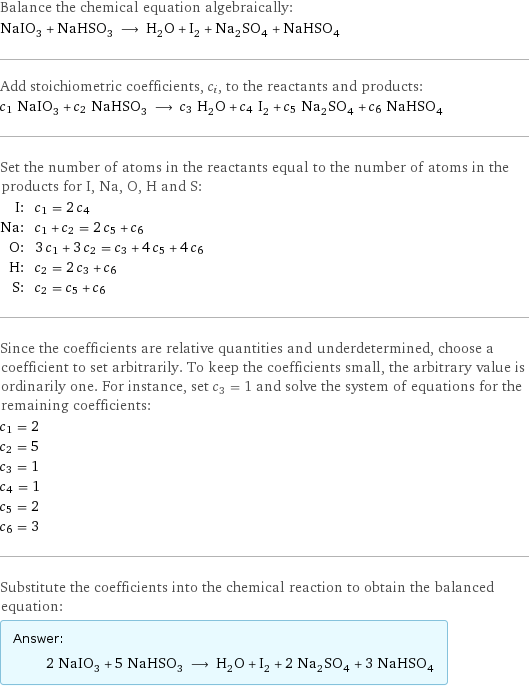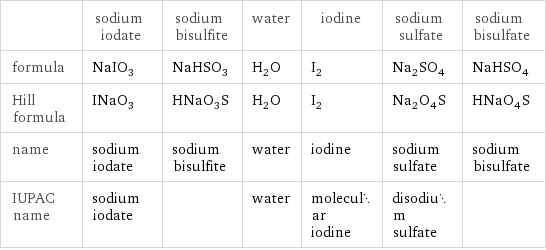Input interpretation

NaIO_3 sodium iodate + NaHSO_3 sodium bisulfite ⟶ H_2O water + I_2 iodine + Na_2SO_4 sodium sulfate + NaHSO_4 sodium bisulfate
Balanced equation

Balance the chemical equation algebraically: NaIO_3 + NaHSO_3 ⟶ H_2O + I_2 + Na_2SO_4 + NaHSO_4 Add stoichiometric coefficients, c_i, to the reactants and products: c_1 NaIO_3 + c_2 NaHSO_3 ⟶ c_3 H_2O + c_4 I_2 + c_5 Na_2SO_4 + c_6 NaHSO_4 Set the number of atoms in the reactants equal to the number of atoms in the products for I, Na, O, H and S: I: | c_1 = 2 c_4 Na: | c_1 + c_2 = 2 c_5 + c_6 O: | 3 c_1 + 3 c_2 = c_3 + 4 c_5 + 4 c_6 H: | c_2 = 2 c_3 + c_6 S: | c_2 = c_5 + c_6 Since the coefficients are relative quantities and underdetermined, choose a coefficient to set arbitrarily. To keep the coefficients small, the arbitrary value is ordinarily one. For instance, set c_3 = 1 and solve the system of equations for the remaining coefficients: c_1 = 2 c_2 = 5 c_3 = 1 c_4 = 1 c_5 = 2 c_6 = 3 Substitute the coefficients into the chemical reaction to obtain the balanced equation: Answer: | | 2 NaIO_3 + 5 NaHSO_3 ⟶ H_2O + I_2 + 2 Na_2SO_4 + 3 NaHSO_4
Structures

+ ⟶ + + +
Names

sodium iodate + sodium bisulfite ⟶ water + iodine + sodium sulfate + sodium bisulfate
Equilibrium constant
![Construct the equilibrium constant, K, expression for: NaIO_3 + NaHSO_3 ⟶ H_2O + I_2 + Na_2SO_4 + NaHSO_4 Plan: • Balance the chemical equation. • Determine the stoichiometric numbers. • Assemble the activity expression for each chemical species. • Use the activity expressions to build the equilibrium constant expression. Write the balanced chemical equation: 2 NaIO_3 + 5 NaHSO_3 ⟶ H_2O + I_2 + 2 Na_2SO_4 + 3 NaHSO_4 Assign stoichiometric numbers, ν_i, using the stoichiometric coefficients, c_i, from the balanced chemical equation in the following manner: ν_i = -c_i for reactants and ν_i = c_i for products: chemical species | c_i | ν_i NaIO_3 | 2 | -2 NaHSO_3 | 5 | -5 H_2O | 1 | 1 I_2 | 1 | 1 Na_2SO_4 | 2 | 2 NaHSO_4 | 3 | 3 Assemble the activity expressions accounting for the state of matter and ν_i: chemical species | c_i | ν_i | activity expression NaIO_3 | 2 | -2 | ([NaIO3])^(-2) NaHSO_3 | 5 | -5 | ([NaHSO3])^(-5) H_2O | 1 | 1 | [H2O] I_2 | 1 | 1 | [I2] Na_2SO_4 | 2 | 2 | ([Na2SO4])^2 NaHSO_4 | 3 | 3 | ([NaHSO4])^3 The equilibrium constant symbol in the concentration basis is: K_c Mulitply the activity expressions to arrive at the K_c expression: Answer: | | K_c = ([NaIO3])^(-2) ([NaHSO3])^(-5) [H2O] [I2] ([Na2SO4])^2 ([NaHSO4])^3 = ([H2O] [I2] ([Na2SO4])^2 ([NaHSO4])^3)/(([NaIO3])^2 ([NaHSO3])^5)](../image_source/4d6bf75798cb33f968ace8edc3f572e6.png)
Construct the equilibrium constant, K, expression for: NaIO_3 + NaHSO_3 ⟶ H_2O + I_2 + Na_2SO_4 + NaHSO_4 Plan: • Balance the chemical equation. • Determine the stoichiometric numbers. • Assemble the activity expression for each chemical species. • Use the activity expressions to build the equilibrium constant expression. Write the balanced chemical equation: 2 NaIO_3 + 5 NaHSO_3 ⟶ H_2O + I_2 + 2 Na_2SO_4 + 3 NaHSO_4 Assign stoichiometric numbers, ν_i, using the stoichiometric coefficients, c_i, from the balanced chemical equation in the following manner: ν_i = -c_i for reactants and ν_i = c_i for products: chemical species | c_i | ν_i NaIO_3 | 2 | -2 NaHSO_3 | 5 | -5 H_2O | 1 | 1 I_2 | 1 | 1 Na_2SO_4 | 2 | 2 NaHSO_4 | 3 | 3 Assemble the activity expressions accounting for the state of matter and ν_i: chemical species | c_i | ν_i | activity expression NaIO_3 | 2 | -2 | ([NaIO3])^(-2) NaHSO_3 | 5 | -5 | ([NaHSO3])^(-5) H_2O | 1 | 1 | [H2O] I_2 | 1 | 1 | [I2] Na_2SO_4 | 2 | 2 | ([Na2SO4])^2 NaHSO_4 | 3 | 3 | ([NaHSO4])^3 The equilibrium constant symbol in the concentration basis is: K_c Mulitply the activity expressions to arrive at the K_c expression: Answer: | | K_c = ([NaIO3])^(-2) ([NaHSO3])^(-5) [H2O] [I2] ([Na2SO4])^2 ([NaHSO4])^3 = ([H2O] [I2] ([Na2SO4])^2 ([NaHSO4])^3)/(([NaIO3])^2 ([NaHSO3])^5)
Rate of reaction
![Construct the rate of reaction expression for: NaIO_3 + NaHSO_3 ⟶ H_2O + I_2 + Na_2SO_4 + NaHSO_4 Plan: • Balance the chemical equation. • Determine the stoichiometric numbers. • Assemble the rate term for each chemical species. • Write the rate of reaction expression. Write the balanced chemical equation: 2 NaIO_3 + 5 NaHSO_3 ⟶ H_2O + I_2 + 2 Na_2SO_4 + 3 NaHSO_4 Assign stoichiometric numbers, ν_i, using the stoichiometric coefficients, c_i, from the balanced chemical equation in the following manner: ν_i = -c_i for reactants and ν_i = c_i for products: chemical species | c_i | ν_i NaIO_3 | 2 | -2 NaHSO_3 | 5 | -5 H_2O | 1 | 1 I_2 | 1 | 1 Na_2SO_4 | 2 | 2 NaHSO_4 | 3 | 3 The rate term for each chemical species, B_i, is 1/ν_i(Δ[B_i])/(Δt) where [B_i] is the amount concentration and t is time: chemical species | c_i | ν_i | rate term NaIO_3 | 2 | -2 | -1/2 (Δ[NaIO3])/(Δt) NaHSO_3 | 5 | -5 | -1/5 (Δ[NaHSO3])/(Δt) H_2O | 1 | 1 | (Δ[H2O])/(Δt) I_2 | 1 | 1 | (Δ[I2])/(Δt) Na_2SO_4 | 2 | 2 | 1/2 (Δ[Na2SO4])/(Δt) NaHSO_4 | 3 | 3 | 1/3 (Δ[NaHSO4])/(Δt) (for infinitesimal rate of change, replace Δ with d) Set the rate terms equal to each other to arrive at the rate expression: Answer: | | rate = -1/2 (Δ[NaIO3])/(Δt) = -1/5 (Δ[NaHSO3])/(Δt) = (Δ[H2O])/(Δt) = (Δ[I2])/(Δt) = 1/2 (Δ[Na2SO4])/(Δt) = 1/3 (Δ[NaHSO4])/(Δt) (assuming constant volume and no accumulation of intermediates or side products)](../image_source/af58164f91a88b4309e783ceda49f33a.png)
Construct the rate of reaction expression for: NaIO_3 + NaHSO_3 ⟶ H_2O + I_2 + Na_2SO_4 + NaHSO_4 Plan: • Balance the chemical equation. • Determine the stoichiometric numbers. • Assemble the rate term for each chemical species. • Write the rate of reaction expression. Write the balanced chemical equation: 2 NaIO_3 + 5 NaHSO_3 ⟶ H_2O + I_2 + 2 Na_2SO_4 + 3 NaHSO_4 Assign stoichiometric numbers, ν_i, using the stoichiometric coefficients, c_i, from the balanced chemical equation in the following manner: ν_i = -c_i for reactants and ν_i = c_i for products: chemical species | c_i | ν_i NaIO_3 | 2 | -2 NaHSO_3 | 5 | -5 H_2O | 1 | 1 I_2 | 1 | 1 Na_2SO_4 | 2 | 2 NaHSO_4 | 3 | 3 The rate term for each chemical species, B_i, is 1/ν_i(Δ[B_i])/(Δt) where [B_i] is the amount concentration and t is time: chemical species | c_i | ν_i | rate term NaIO_3 | 2 | -2 | -1/2 (Δ[NaIO3])/(Δt) NaHSO_3 | 5 | -5 | -1/5 (Δ[NaHSO3])/(Δt) H_2O | 1 | 1 | (Δ[H2O])/(Δt) I_2 | 1 | 1 | (Δ[I2])/(Δt) Na_2SO_4 | 2 | 2 | 1/2 (Δ[Na2SO4])/(Δt) NaHSO_4 | 3 | 3 | 1/3 (Δ[NaHSO4])/(Δt) (for infinitesimal rate of change, replace Δ with d) Set the rate terms equal to each other to arrive at the rate expression: Answer: | | rate = -1/2 (Δ[NaIO3])/(Δt) = -1/5 (Δ[NaHSO3])/(Δt) = (Δ[H2O])/(Δt) = (Δ[I2])/(Δt) = 1/2 (Δ[Na2SO4])/(Δt) = 1/3 (Δ[NaHSO4])/(Δt) (assuming constant volume and no accumulation of intermediates or side products)
Chemical names and formulas

| sodium iodate | sodium bisulfite | water | iodine | sodium sulfate | sodium bisulfate formula | NaIO_3 | NaHSO_3 | H_2O | I_2 | Na_2SO_4 | NaHSO_4 Hill formula | INaO_3 | HNaO_3S | H_2O | I_2 | Na_2O_4S | HNaO_4S name | sodium iodate | sodium bisulfite | water | iodine | sodium sulfate | sodium bisulfate IUPAC name | sodium iodate | | water | molecular iodine | disodium sulfate |
Substance properties

| sodium iodate | sodium bisulfite | water | iodine | sodium sulfate | sodium bisulfate molar mass | 197.891 g/mol | 104.1 g/mol | 18.015 g/mol | 253.80894 g/mol | 142.04 g/mol | 120.1 g/mol phase | solid (at STP) | solid (at STP) | liquid (at STP) | solid (at STP) | solid (at STP) | solid (at STP) melting point | 425 °C | 150 °C | 0 °C | 113 °C | 884 °C | 181.85 °C boiling point | | | 99.9839 °C | 184 °C | 1429 °C | density | 3.56 g/cm^3 | 1.36 g/cm^3 | 1 g/cm^3 | 4.94 g/cm^3 | 2.68 g/cm^3 | 1.8 g/cm^3 solubility in water | | | | | soluble | surface tension | | | 0.0728 N/m | | | dynamic viscosity | | | 8.9×10^-4 Pa s (at 25 °C) | 0.00227 Pa s (at 116 °C) | | odor | | | odorless | | |
Units
